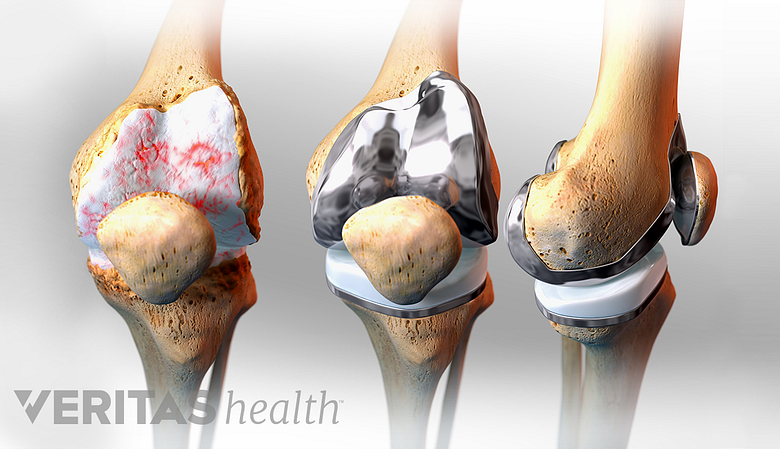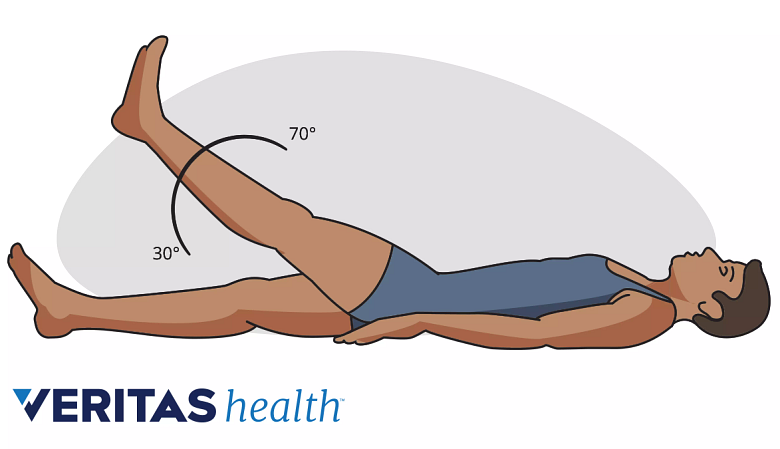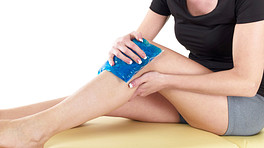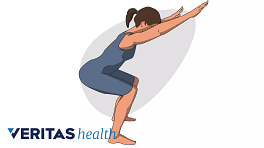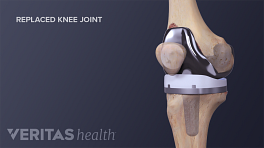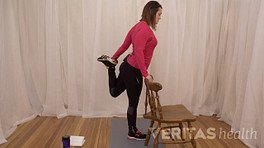If you recently had a total knee replacement, you’re probably experiencing some pain, including pain at the front of your thigh. The quadriceps tendon, which is located above the kneecap, is typically cut and sutured back together during surgery. Physical therapy exercises that engage your quad muscles—along with rest and active management of knee swelling—are essential to your healing, recovery, and pain reduction.
- Your quadriceps femoris (quad) is made up of 4 large muscles at the front of the thigh. When they are contracted, the knee straightens.
- The quadriceps tendon attaches the large quad muscles to the kneecap. The quad tendon extends into the patellar tendon, which attaches to the kneecap and the front part of the upper shin.
- The quad muscles and tendons are essential for knee stability and movement. They keep the knee from buckling, and they help absorb impact forces during activity.
- After a traditional knee replacement surgery, it typically takes 10 to 12 weeks for the quad tendon tissue to heal. It will probably take longer to regain all strength and function.
After surgery, scar tissue can build up around the quad tendon and other soft tissues. While scar tissue is very important in the initial healing process as it protects the incision, it can:
- Keep you from being able to fully straighten your knee or bend it enough to get in and out of chairs or car seats comfortably.
- Prevent you from restoring a normal walking pattern.
To prevent excess scar tissue from forming, it is important to be consistent with your prescribed physical therapy exercises.
Here are 5 exercises that orthopedic surgeons and physical therapists may assign to you during your recovery. Because of how important it is to restore movement and function, surgeons and physical therapists require you do these exercises periodically throughout the day (typically for 1 to 2 minutes every 1 to 2 hours).
1. Quad squeezes (early recovery)
This simple exercise doesn’t involve any leg movement. A towel is an optional prop.
- Lie on your back on the floor or in bed with your recovering leg extended and your healthy leg bent at the knee. (Note: There is a reflex in the body that makes one knee flex when the other extends. If you are trying to activate the quadriceps to straighten the affected knee, having the opposite knee bent allows you to take advantage of this reflex, which will be helpful when it is time to start walking.)
- Roll up a towel and place it under your new knee, allowing the knee joint to be slightly bent. (Using a towel is optional. It tends to make things more comfortable as you activate your quad.)
- Activate the quad as you gently press the knee down into the towel roll (if using one).
- Hold the muscle squeeze for 5 seconds, then fully release it. Fully releasing your muscles in between squeezes will help you make that muscle contraction more efficient over time.
Contracting and releasing the muscle encourages blood flow and gets muscle fibers working.
2. Short arcs quads (early recovery)
You’ll need a rolled-up towel for this exercise.
- Lie on your back with your unaffected knee bent and the rolled-up towel under your new knee. (Your new knee will be slightly bent.)
- Tighten your quadriceps to press the knee into the towel roll.
- Lift the heel off the floor without lifting the knee off the towel.
- Hold for 5 seconds, then lower your heel.
Short arcs are similar to quad squeezes, but the lifting of the heel increases the resistance on the quad. This exercise is very helpful for increasing strength and improving the ability to straightening the knee joint.
See more exercises you can do in the early recovery stage after knee replacement surgery: Knee Replacement Surgery Rehabilitation Exercises
3. Step-ups (3 to 6 weeks)
This exercise requires a set of stairs with a sturdy handrail. If stairs are not available, try placing a step stool next to a sturdy surface that you can grip, such as the edge of a counter or sink.
- Stand upright in front of the set of stairs. Place one hand firmly on the handrail.
- Lift your leg by bending your operated knee and place your foot on the lowest stair.
- Step up onto the first stair, pressing down into the stair. Think about activating the gluteus maximus muscles (glutes) and quad muscles together to straighten the knee.
- Hold for a few seconds.
- Slowly bend your new knee, lowering yourself back into starting position (both feet on the floor).
Do this exercise slowly. Going slowly will help you build muscle, endurance, and control, and will also help prevent an accidental fall.
4. Straight leg raises (2 to 4 weeks)
Start by lying on your back with your nonsurgical knee bent and your recovering leg straight.
- Tighten the quad to straighten the new knee.
- While keeping your knee straight, lift the recovering leg straight up into the air.
- Once the thighs are parallel to each other, hold for 2 to 3 seconds.
- Slowly lower the leg so that the heel touches the floor before your knee does (this will help keep the Quad active during the entire lowering of the leg).
Before each leg raise, activate your abdominal muscles so that your core is engaged. This will improve your overall fitness and stability for walking on your new knee.
5. Wall squats (6 weeks or more after knee replacement surgery)
These squats are a great way to maintain strength in your quad muscles as well as your glute and calf muscles.
- Stand with your back against a wall. Place your feet hip-width apart and 12 to 18 inches away from the wall.
- Slide your back down the wall by slowly bending your knees to a 45° angle, or to whatever depth works the quadriceps without any knee pain. Hold this squat position for 5 seconds.
- Activate your quads as well as the glute muscles in your buttocks to straighten your knees, sliding back up the wall.
Alternatively, a health care provider may recommend you do shallow squats while holding on to a countertop in front of you.
Your quads are just one muscle group affected by knee replacement surgery. Additional exercises can help you strengthen your calf muscles and hamstrings.
See Knee Strengthening Exercises
Always check with your doctor or therapist to make sure specific exercises are appropriate for your condition and situation first, and stop immediately any exercise that causes an increase in pain.
